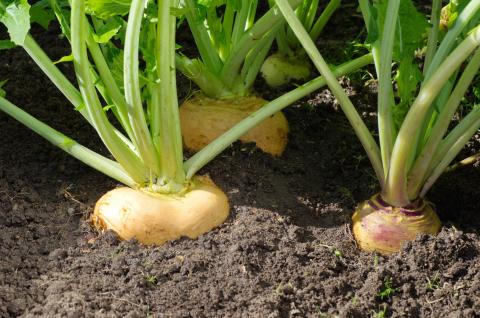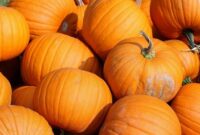Turnips are cool-weather vegetables that can be grown both in spring and fall. They mature quickly and both the bright greens and roots can be enjoyed. Learn more about this ancient root vegetable—from planting to harvesting.
About Turnips
Turnips will grow in spring or fall weather. They do not like hot summer months. Note that an autumn crop seeded in late summer is usually sweeter and more tender than a spring crop, and pests are less of a problem.
Turnips are seeded directly into the garden; they do not transplant well. Plus, they germinate in only a few days. Within a month, their greens are ready to harvest, and within a second month, the swollen roots are be taken up.
Turnips can be eaten raw, baked, boiled, roasted, or mashed. Prepare turnips as you would carrots. Or, try them as an alternative to potatoes; we enjoy a turnip gratin.
Turnips grow best in full sun when temperatures range from 40° to 75°F. As soon as the garden can be worked, loosen the soil to a depth of 12 to 15 inches. Mix in 2 to 4 inches of aged manure and/or compost. Add more to heavy, clay soil to improve drainage.
When to Plant Turnips
- For a late spring harvest, sow turnip seeds about 2 to 3 weeks before the average last spring frost date.
- For an autumn harvest, sow turnips in late summer after summer crops of onions, squash, beans or sweet corn.
- For a later autumn harvest, sow seeds in early autumn.
How to Plant Turnips
- Before planting, mix in a nice low organic fertilizer (such as a 5-5-5) about 12 inches into the soil. Avoid over-fertilizing with nitrogen or you’ll get leafy greens at the expense of a big root. Avoid a Miracle Gro or any high-nitrogen fertilizer.
- Sow seeds directly in the soil 1/4 to 1/2 of an inch deep, 1 inch apart, in rows 12 to 18 inches apart.
- You can also scatter turnip seed and thin later.
- Cover seeds with not more than 1/2 an inch of soil.
- Water well and consistently.
- Protect spring crops from pests with row covers at planting.
-
Once seedlings are 4 inches high, thin them to 4 to 6 inches apart. Crowding can result in small or malformed roots. If you grow them any closer than 4 inches, they’re not going to grow.
-
Keep the beds weed-free, but be careful of disturbing the root of young turnips.
- Mulch heavily to retain moisture and suppress weeds.
- Turnips do not need much care, but consistent soil moisture is important. Water regularly to keep soil lightly moist, One inch per week should prevent roots from becoming tough and bitter.
Avoid Bolting
Turnips are hardy biennials, even though we treat them as annuals. They naturally flower and go to seed (bolt) in the second year. Bolting in the first year could be due to stress, such as caused by extreme temperatures (cold or hot) or lack of nutrients or water. Such stresses can also result in little or no root growth, a root that grows above ground, or greens only.
Be sure to pick turnips before temperatures get into the 80s to avoid bolting.
Click on links for more information about the relevant pest:
- Aphids
- Cabbage Root Maggots
- Flea Beetles
- Powdery Mildew
- Downy Mildew
- Black Rot
- Stinkbugs
- White Rust
Many turnips are grown not for the root itself but for the turnip greens, which can be cooked or used raw in salads. Younger turnip greens will not be as bitter as mature leaves. If you are growing turnips primarily for their greens, most any turnip variety will do.
For roots, try these …
- ‘Gold Ball’: yellow skin, soft, yellow flesh; harvest at 3 inches in diameter for maximum sweetness (will grow to 4 to 5 inches)
- ‘Just Right’: pure white roots, delicious greens; extremely cold-tolerant; stores well; not recommended for a spring crop, as it tends to bolt early
- ‘Purple Top White Globe’: delectable leaves; great for an extended production of greens; roots have purple shoulders; heirloom
- ‘Golden Globe’: roots with amber skin; firm, crisp, sweet flesh; tasty tops.
- Harvest greens when turnips are small; the leaves taste best when young and tender. Cut leaves 2 inches above the base; they may grow back. Harvest jut a few at a time, if also growing for roots.
- Harvest roots at any time; however, small, young turnips are more tender. Often early types are harvested after about 5 weeks. Main crop types after 6 to 10 weeks.
- For fall turnips, consider harvesting after one or two light frosts (but before a hard freeze) for a sweeter taste.
- Mulch to harvest later in the season and to protect from a hard freeze.
How to Store Turnips
- Store for up to 3 or 4 months in a cool (32° to 38°F), dark place such as a root cellar or store in the refrigerator for up to 2 weeks.
- If storing in the refrigerator, keep turnips in a perforated plastic bag. It’s important that the turnips do not dry out, but also that they do not become moldy from too much moisture.
- To freeze: Peel, wash, cut into 1/2-inch cubes, blanch for 3 minutes, cool immediately in cold water, and drain. Pack into containers, label, and freeze.
- “Turnips like a dry bed but a wet head.”
- Turnips are often confused with rutabagas because they are similar, and people like to plant them together. The two root vegetables grow well under the same conditions, but rutabagas take about four weeks longer to mature.
- In 19th-century Ireland, Halloween jack-o’-lanterns were carved from turnips, not pumpkins. Lit by a candle inside, the grotesque faces were intended to scare away demons and evil spirits.
If you’re wondering how to cook turnips, you’re not alone. Both the turnip greens and roots are very nutritious. Turnip roots should generally be peeled and sliced before using them. Both turnip roots and turnip greens are usually cooked, though they can be eaten raw if young and tender.




